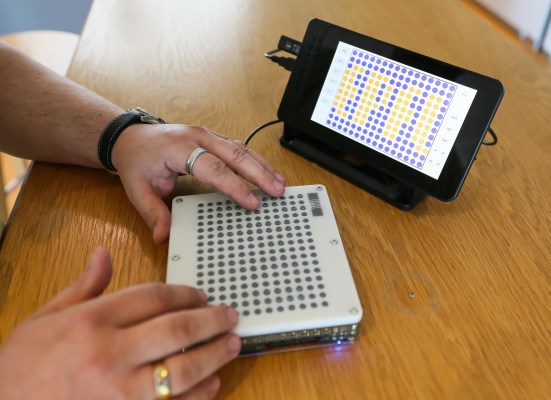It’s truly amazing, the wealth of information we all have at our fingertips — that is, of course, unless your fingertips are how you have to access that information. An innovative new tablet that uses magnetically configurable bumps may prove to be a powerful tool for translating information like maps and other imagery to a modality more easily accessed by the visually impaired.
The tablet, unnamed as yet, has evolved and improved over the past few years as part of Europe’s BlindPAD project, which aims to create a cheap, portable alternative to touchscreen devices. It’s developed by researchers at the École polytechnique fédérale de Lausanne.
The latest prototype is about the size of a thick iPad mini, and it uses a clever mechanism to raise and lower the bumps that form images, letters or Braille (although they’re rather large for it). Each little bump is attached to a magnet; the magnet is always attached to one of two steel layers, and can be switched by running a current briefly through an adjacent coil. Like an e-paper screen, no power is required to keep it in its current position, making it very efficient.
The process is quick enough, though, that the dots can animate or vibrate for feedback, and could detect being pressed or glided over by a hand.
The idea isn’t to create a Kindle for the blind, however; Braille displays must be much higher density. That usually requires a different type of haptic display, such as the one used by Blitab. The BlindPAD tablet has 12 rows and 16 columns, for a total of 192 potential bumps, “taxels” as some have called them. That’s much better suited to things better shown than described.
“People can read with a Braille display, and detect nearby obstacles with a white cane,” said EPFL’s Herbert Shea in a news release. “Our tablet, which will not cost much to produce, will provide graphic information in real time, so the user can check out the layout of a room or street before venturing into it.”
It could indicate where safe crossings are on a map of a corner, tell which of two doorways goes to the appropriate locker room, or allow a visually impaired student to inspect a chart or geometry problem in class as easily as their sighted peers. A study performed last year found that using the tablet instead of the equivalent in raised dots on paper had similar benefits for young students.
Our results demonstrate that programmable maps are an effective way to display graphical contents in educative/rehabilitative contexts. They can be at least as effective as traditional paper tests yet providing superior flexibility and versatility.
BlindPAD’s tablet is still very much in development, but it’s come a long way since its earlier iterations. The current one is more efficient, wireless and at least kind of portable.
The technique could also be applied, Shea said, to sighted people in the form of, for example, gloves that press on the hand, giving similar spatial information or perhaps tactile feedback in virtual reality.
The team is showing their latest results at the ACM CHI conference in Denver this week.
